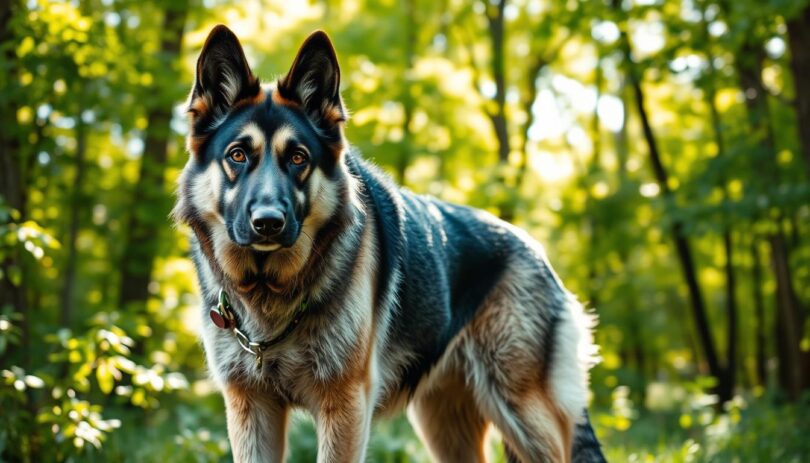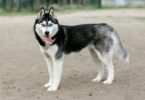Have you ever seen a dog that stops you in your tracks? Imagine a loyal companion with the intelligence of a working breed and a coat that looks like nature’s masterpiece. This is the Panda German Shepherd—a striking variant of the traditional GSD, marked by rare white patches that create a one-of-a-kind appearance.
Unlike standard black-and-tan shepherds, this crossbreed sports a piebald pattern caused by a spontaneous KIT gene mutation. No white ancestry is involved—its origins trace back to Frankie, a founding dog whose unexpected coloring sparked interest in the 2000s. Despite this genetic twist, these dogs retain the size, strength, and temperament of classic working-line shepherds.
Owners like Benny and Calliope’s families report the same traits you’d expect: sharp minds, protective instincts, and unwavering loyalty. The difference lies in their visual appeal—splotches of white blending with darker fur like living abstract art.
Whether you’re drawn to their rarity or their proven capabilities, these dogs challenge expectations. Upcoming sections will explore how their genetics work, what daily care entails, and why they’re winning hearts nationwide.
Discovering the Origins and Genetics of the Panda German Shepherd
Behind every unique coat lies a genetic story waiting to be told. Researchers uncovered the science behind this breed’s striking patterns through meticulous DNA analysis. At Ohio State University Veterinary Hospital, scientists studied a dog named Lewcinka’s Franka von Phenom, confirming the mutation responsible for the distinct markings.
The Spontaneous Mutation and KIT Gene
A spontaneous change in the KIT gene creates the breed’s signature white patches. This mutation alters pigment cell development during embryogenesis. DNA tests proved neither parent carried the trait—it emerged unexpectedly in one litter.
The mutation follows an autosomal dominant pattern. Offspring need just one copy to display the trait. However, inheriting two copies is fatal, making ethical breeding practices critical. Breeders use cell brushing techniques to collect genetic material safely.
From Traditional GSDs to the Panda Pattern
Traditional bloodlines played a key role in preserving the mutation. Frankie, the first dog with this trait, passed it to 45% of her puppies. Breeders now prioritize DNA testing parents to avoid doubling the gene.
Studies show the mutation doesn’t affect health or temperament. It simply modifies coat color distribution. By understanding these genetics, owners can appreciate how rare biology shapes this working breed’s iconic look.
Understanding the Temperament and Working Traits
A dog’s true value lies not just in its appearance but in its ability to connect and contribute. These intelligent canines inherit a legacy of purpose-driven behavior, shaped by generations of herding and guarding livestock. Their sharp minds thrive when given clear tasks, making them ideal partners for active households.
Work Ethic, Loyalty, and Training Potential
Bred for reliability, these shepherd dogs excel in roles demanding focus and discipline. Police units value their problem-solving skills during search operations, while service organizations praise their calmness in therapy settings. Structured training sessions using rewards like treats or praise yield rapid progress.
Early exposure to diverse environments helps puppies develop confidence. Puppy socialization classes introduce them to new sounds, surfaces, and people—building adaptability. Owners report that consistent routines prevent boredom-related behaviors like chewing or digging.
Socialization and Family Integration
Families appreciate their natural protective instincts balanced with gentle interactions. Successful integration starts during the puppy stage by introducing children slowly and supervising play. Daily walks or puzzle games channel their energy positively.
Trust forms through predictable interactions. Simple gestures like feeding at set times or using consistent commands strengthen bonds. Many become inseparable from their people, often choosing to sleep near doorways as vigilant guardians.
Health, Exercise, and Grooming Essentials
Maintaining peak condition requires understanding three pillars: preventive care, activity balance, and coat maintenance. While their striking appearance draws attention, responsible ownership means prioritizing wellness strategies tailored to their biological needs.
Managing Health Concerns and Genetic Testing
Hip and elbow dysplasia remain common concerns, with studies showing 19% prevalence in related breeds. Early screening through OFA certifications helps identify joint issues before symptoms appear. Responsible breeders provide DNA test results for degenerative myelopathy and bleeding disorders.
White spotting patterns don’t increase health risks but require sun protection for pale skin areas. Annual vet checks should include cardiac exams and thyroid panels. Owners report fewer emergencies when tracking exercise-induced fatigue through wearable activity monitors.
Exercise Routines and Daily Grooming Tips
These active dogs need 90+ minutes of daily exertion. Combine fetch sessions with scent work puzzles to engage both body and mind. Agility courses or structured hikes prevent destructive behaviors linked to pent-up energy.
Their double coat sheds heavily seasonally. Use an undercoat rake weekly, increasing to daily during spring blowouts. Bathing every 6-8 weeks preserves natural oils—overwashing dulls the coat color. For detailed techniques, consult this complete care guide.
Brushing distributes skin oils evenly, enhancing the white spotting contrast. Trim nails monthly to avoid posture issues. Wipe ears biweekly with vet-approved solutions to prevent infections common in active dogs.
Caring for Your panda german shepherd: Training, Diet, and Daily Needs
Raising a dog with exceptional intelligence and energy demands a thoughtful approach. Successful care combines structured routines, nutritional precision, and spaces designed for both play and relaxation. Let’s break down the essentials for nurturing these unique companions.
Effective Training Strategies and Behavioral Tips
High-drive dogs thrive on challenges that engage their problem-solving skills. Reputable breeders recommend starting obedience training at 8–10 weeks, using reward-based methods like clickers or treats. Rotate activities between agility drills and scent games to prevent boredom.
Dogs with distinctive markings often attract extra attention. Teach polite greetings early to curb jumping or overexcitement. Consistent commands like “place” or “quiet” help manage reactions to strangers. Puzzle feeders channel mental energy constructively during downtime.
Feeding Guidelines and Living Environment Recommendations
Active breeds require diets rich in animal protein (25–30%) and healthy fats. Split meals into three portions daily to maintain energy levels without bloating. Avoid free-feeding—measured portions prevent obesity in less active periods.
Indoors, secure trash cans and fragile items. Outdoors, install a 6-foot fence for safe sprinting sessions. Provide shaded areas for dogs with lighter coat patches to avoid sunburn. A dedicated digging sandbox preserves gardens while satisfying natural instincts.
Pair physical exercise with socialization outings. Weekly visits to parks or pet stores reinforce calm behavior around distractions. This balance ensures a well-adjusted companion ready for any adventure.
Bringing It All Together: Embracing the Panda German Shepherd Lifestyle
Owning a dog with striking markings isn’t just about looks—it’s embracing an active partnership. These athletic companions combine a robust chest and agile frame with a coat showcasing nature’s artistry. Their bold pattern blends dark and light fur in irregular splashes, creating a living canvas that turns heads at every park visit.
Beyond aesthetics, their working heritage shines through. Structured exercise and mental challenges keep their sharp minds engaged. Daily grooming maintains that iconic spotting while strengthening your bond through routine care.
Choosing this breed means committing to adventure. Long hikes, training drills, and family play sessions become shared joys. Their loyalty and protective instincts thrive when matched with consistent leadership and affection.
Prospective owners should ask: Are you ready to channel their energy productively? Can you provide the care their unique coat demands? Answer yes, and you’ll gain a devoted partner ready to enhance every aspect of life—from morning jogs to quiet evenings guarding the homefront.
FAQ
What causes the unique coat pattern in these dogs?
The striking white-and-tan markings result from a spontaneous mutation in the KIT gene, which affects pigment distribution. Unlike traditional German Shepherds, this genetic variation creates irregular patches without links to merle or albinism.
Are there specific health risks associated with this coloration?
While generally healthy, responsible breeders conduct DNA testing for degenerative myelopathy and hip dysplasia. The KIT gene mutation itself doesn’t cause health issues, but routine screenings through organizations like OFA are recommended.
How does their temperament compare to standard German Shepherds?
They share the breed’s intelligence and loyalty but require early socialization. Their high work ethic thrives with structured tasks, making them excellent candidates for obedience training or agility competitions.
What grooming routines suit their double coat?
Weekly brushing with an undercoat rake manages shedding, increasing to daily sessions during seasonal changes. Baths should be limited to every 6-8 weeks using pH-balanced shampoos to preserve skin oils.










Leave a Comment